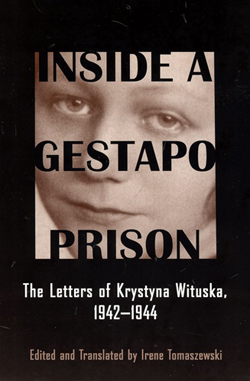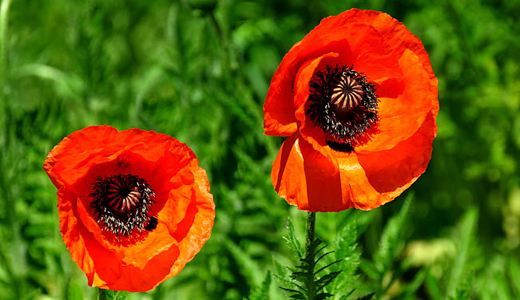 The Russian proverb: Бог тро́ицу лю́бит (Bóg Trójcy lubϊt. ‘God loves Trinity’) spiritualizes the commonly held belief that “The third time is a charm.” The third annual Slavic Performing Arts Festival at Luzerne County Community College in Shamokin, Pennsylvania certainly embodied both charm and reverence. These aspects of the Slavic soul have been a recurring feature each year, personified so well during the latest production, a drama based on the actual letters written by a young member of the Polish resistance during her imprisonment in Berlin during World War II. Translated and edited by Irene Tomaszewski, the letters were published by Wayne State University Press under the title, Inside a Gestapo Prison: The Letters of Krystyna Wituska. I chose Natalya Zmudzin, a very talented Emory University theatre student to play the title role. Adding another dimension and third person to the event’s trinity, Irene Tomaszewski was invited to speak and sign books.
The Russian proverb: Бог тро́ицу лю́бит (Bóg Trójcy lubϊt. ‘God loves Trinity’) spiritualizes the commonly held belief that “The third time is a charm.” The third annual Slavic Performing Arts Festival at Luzerne County Community College in Shamokin, Pennsylvania certainly embodied both charm and reverence. These aspects of the Slavic soul have been a recurring feature each year, personified so well during the latest production, a drama based on the actual letters written by a young member of the Polish resistance during her imprisonment in Berlin during World War II. Translated and edited by Irene Tomaszewski, the letters were published by Wayne State University Press under the title, Inside a Gestapo Prison: The Letters of Krystyna Wituska. I chose Natalya Zmudzin, a very talented Emory University theatre student to play the title role. Adding another dimension and third person to the event’s trinity, Irene Tomaszewski was invited to speak and sign books.
Setting the stage I drew comparisons to modern day freedom fighters in the Middle East as well as those vilified individuals fighting for economic freedoms in America’s Midwest. The audience was then encouraged to meet the Wituska character on a personal level.
 In Ms. Zmudzin’s riveting portrayal of the young heroine, the letters in essence became another character on stage with her, as she gently caressed the tender letters, joyfully tossed the playful ones, and clutched, concealed or helplessly let go of the painful ones. She became Krystyna, physically and emotionally; she became everyone’s daughter, sister or friend, and the audience, young and old, male and female, all of them sharing her hopes, her fears, her laughter and her sorrows. A brilliant, insightful and moving performance.
In Ms. Zmudzin’s riveting portrayal of the young heroine, the letters in essence became another character on stage with her, as she gently caressed the tender letters, joyfully tossed the playful ones, and clutched, concealed or helplessly let go of the painful ones. She became Krystyna, physically and emotionally; she became everyone’s daughter, sister or friend, and the audience, young and old, male and female, all of them sharing her hopes, her fears, her laughter and her sorrows. A brilliant, insightful and moving performance.
Following the performance Ms. Zmudzin (pictured at right) joined me, and special guest Irene Tomaszewski, to answer questions from the audience. In addition to students and community members interested in World War II, the Holocaust or Women’s Studies, a number of my General Psychology students attended the event and wrote reports using terms we have discussed in class. Instead of just reporting on the event, I wanted to share with you their psychological analyses of the event.
“I found myself moved by the young woman’s strong will, resilience and her ability to find pleasure in the smallest details of life, despite the appalling circumstances of her situation. When a person such as Krystyna, in the process of life, finds herself compelled to step out of the comfort zone of safety, willing to place her own life in danger, in her own words, “for freedom and justice of all humanity,” I would feel safe to speculate that she had reached the highest level on Abraham Maslow’s hierarchy pyramid [self-actualization: reaching full personal potential] as well as stage six of Lawrence Kohlberg’s Post-Conventional principled moral thinking [the Universal Ethical where abstract, autonomous moral principles now judge laws for true justice].”
– Crystal Killmon, General Studies, Sunbury PA
Maslow, who was the first of seven children born to Jewish immigrants from Kyiv, implied that attainment of basic physiological and emotional needs should be satisfied before self-actualization could be possible. Yet Maslow also wrote of Gemeinschaftsgefühl a term he borrowed from Austrian psychotherapist Alfred Adler. Gemeinschaftsgefühl is an identification and affectionate feeling, often referred to as the “older-brotherly love” which drives some people to place others before themselves. For this reason the idea of self-actualization may be possible even though fundamental personal needs are not yet satisfied. Wituska, like so many martyrs before her, transcends her own plight in an attempt to comfort others.
“She made herself a doll and named it after her friend to provide comfort. The attachment to her friend helped to make her feel more comfortable with being in prison. This made her cope better with the tough times she would endure. When the holidays were approaching she would find it hard to be brave and not be weak. Thinking of the holidays, she would remember her time at home to get through those difficult times. Seeing the flowers blooming and the chestnut tree outside her window gave her a reason to live.”
– Carolyn Yucha, General Studies, Kulpmont, PA
We find Wituska engaged in very mature defense mechanisms such as anticipation, humor and sublimation of negative thoughts into positive emotions. These were the highest coping strategies identified by George Vaillant who was interested in the topic since childhood after his father and namesake committed suicide. These healthy coping strategies allow Wituska to not only comfort herself, but also to comfort the loved ones to whom she is writing.
“She was so concerned about what they were going through even though she was the one in prison. That, I feel, comes from a positive life growing up. If she would have been raised with doom and gloom she would not have been so positive in a time when most probably were depressed and negative. Even in her knowing she was going to be killed she was ready and had faith that she was ready. It reminded me of Resiliency.”
– Melissa Parker, Early Childhood Education, Mount Pleasant Mills, PA
The concept of resiliency or ability to steel oneself in a positive way against stress was a trait of Wituska. While several psychologists have researched resiliency and offered varying definitions since the 1970s, resulting definitions share similar characteristics. Resilient individuals have a positive realism, meaning they avoid both negative as well as unrealistic views of their world. The ability to develop relationships with substitute caregivers is another quality of resilient people. Wituska does this by befriending the prison guard ‘Sunshine’, her daughter Helga ‘Teddy,’ as well as other prisoners. Other aspects of resiliency include self-awareness and determination. Reading Wituska’s letters one can understand that she was both aware of her condition yet determined to advance her softer humanism as an alternative to the fascist state.
“Inattentive blindness is in our everyday lives just like it was in Krystyna’s [time]. We take a lot for granted in life: for instance the outside world. Krystyna didn’t have the pleasure to see the outside world and the sky like we do today. This presentation opened my eyes. Enjoy every little moment in life even if it’s just a breath of fresh air or a hug from a friend. Life is precious and so is each individual.”
–Jasmine Palovick, General Studies, Coal Township, PA
Arien Mack and Irvin Rock coined the phrase “inattentional blindness” as failing to perceive things in plain sight. The researcher duo illustrated that viewing is not the same as processing information. Much of our world goes by us without being recorded in our memories, from small details to major events.
A question that was repeated by many audience members was, “How could the people in the 1930s allow the Nazis’ rise to power?” Certainly there are many possible explanations for this, from the benign to the malignant. Blindness to changes, a form of inattentional blindness, may also be a factor. This is especially true considering social psychologist Phillip Zimbardo’s recipe for awakening evil traits within otherwise good people. Zimbardo is famed for his controversial 1971 Stanford Prison Experiment which depersonalized subjects who committed sadistic acts on each other. Because of his research Zimbardo was an expert witness during the Abu Ghraib prison abuse trials. His ongoing research and publications theorize that most people will follow the evil orders of a popular leader if contractual agreements were originally made and some amount of dissention but not insurrection is permitted. Wituska and her Polish Underground cohorts were able to resist occupying forces not only because of their strong moral character, but because they also had strength in numbers and could comfort each other in those darkest nights.
CR




Pingback: Krystyna Wituska: Her Life and Literary Afterlife